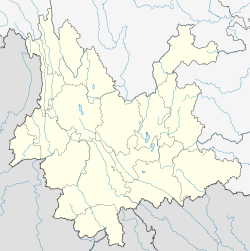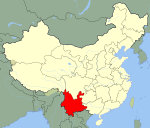- Mengzi City
-
Mengzi
蒙自— County-level city — 蒙自市 Location within Yunnan Province Coordinates: 23°22′N 103°24′E / 23.367°N 103.4°ECoordinates: 23°22′N 103°24′E / 23.367°N 103.4°E Country People's Republic of China Province Yunnan Prefecture Honghe Hani and Yi Autonomous Prefecture Area – Total 2,228 km2 (860.2 sq mi) Population – Total 330,000 – Density 148.1/km2 (383.6/sq mi) Postal code 661100 Area code(s) 0873 Website http://www.mzxzfw.gov.cn/ Mengzi (Chinese: 蒙自; pinyin: Měngzì) is a city in the southeast of Yunnan province, Southwest China. It is part of the Honghe Prefecture, located about 23 kilometres (14 mi) east of Gejiu. It is situated in the centre of a fertile valley basin on a plateau 1,000 metres (3,300 ft) above sea level. Mengzi was formerly Mengzi County (蒙自县) until October 2010, when it was upgraded to a county-level city.[1]
Contents
Government
The county seat is in Wenlan Town.
Climate
Climate data for Mengzi (1971−2000) Month Jan Feb Mar Apr May Jun Jul Aug Sep Oct Nov Dec Year Average high °C (°F) 18.9
(66.0)21.2
(70.2)25.3
(77.5)27.9
(82.2)28.4
(83.1)28.1
(82.6)27.5
(81.5)27.4
(81.3)26.4
(79.5)24.1
(75.4)21.1
(70.0)18.6
(65.5)24.58
(76.24)Average low °C (°F) 7.8
(46.0)9.6
(49.3)12.8
(55.0)16.2
(61.2)18.5
(65.3)19.9
(67.8)19.6
(67.3)18.8
(65.8)17.5
(63.5)15.2
(59.4)11.4
(52.5)7.8
(46.0)14.59
(58.27)Precipitation mm (inches) 14.8
(0.583)19.2
(0.756)26.9
(1.059)46.2
(1.819)96.9
(3.815)109.8
(4.323)175.0
(6.89)160.2
(6.307)100.1
(3.941)51.2
(2.016)45.9
(1.807)12.8
(0.504)859
(33.82)% humidity 70 65 60 62 69 75 79 81 78 76 75 72 71.8 Avg. precipitation days (≥ 0.1 mm) 4.9 5.0 6.1 10.2 14.6 16.5 20.2 20.6 16.1 11.4 7.0 3.8 136.4 Sunshine hours 208.9 204.9 230.6 226.3 200.2 138.4 140.0 148.9 149.0 153.4 166.0 194.8 2,161.4 Source: China Meteorological Administration Food
The Mengzi region is well-known for a dish called guoqiao mixian ("Over the Bridge Rice Noodle"), made with long rice-flour noodles.
History
In the 19th century, Mengzi was a trading centre for commerce between the interior of Yunnan and the Hanoi-Haiphong area of Vietnam.
In 1886, a French convention chose Mengzi to be the center of trade in Yunnan province for importing and exporting goods via Tongking in Vietnam. Facilities for this opened 2 years later.
Communications were inconvenient: goods were shipped to Hekou on the Vietnamese border by junk, transferred by small craft to Manhao, and then taken 60 km by pack animal to Mengzi. Despite these difficulties, Mengzi was an important port of entry into both Yunnan and western Guizhou provinces, and in 1889 it was opened to foreign trade as a treaty port. Most of this foreign trade was in tin and opium. Its main exports were tin and opium, and the main imports were mostly textiles (primarily cotton) and tobacco.
As a trading center, the city gradually began to lose its importance beginning from the early 20th century. The importance of Mengzi was ended by the construction of the French railway from Haiphong to Kunming (the Yunnan provincial capital) in 1906–10. This railway bypassed Mengzi, but in 1915 a branch line was built via the town to the Gejiu tin mines. Apart from a brief respite during the early days of World War II, the town of Mengzi has, nevertheless, steadily declined in importance ever since.
Gejiu became a county in 1913, and a city in 1951. With the improvement of communications and transportation between cities of Gejiu and Kaiyuan and the other counties nearby, plus the development of trade between southwestern China and the countries of Southeast Asia, Mengzi's ties have increasingly strengthened with Gejiu and Kaiyuan. The whole area has become a border economic centre. In addition to tin, the county's natural resources include coal, manganese, lead, zinc, and antimony.
When Japanese troops drove Beijing and Tianjin university professors, students, and administrators out of those cities, and then later out of Changsha as well, the academics made their own long march to Yunnan Province. They first established themselves in Mengzi, but after a year or so moved on to the provincial capital, Kunming. This was Lianda, or the Southwest Associated Universities.
Recently, the prefectural government has moved from nearby Gejiu to Mengzi. New wealthy suburbs and large government offices have sprung up as a result, but much of the poverty remains, creating a large wealth gap within the city.
Economy
Like nearby Gejiu, mining, mostly of tin, is a large part of its economy.
References
- ^ "云南蒙自县申报设市获得国家民政部批复—". Sina.com. 13 October 2010. http://news.sina.com.cn/c/2010-10-13/100518224906s.shtml. Retrieved 2011-03-22.
- BBC report on Mengzi
 This article incorporates text from a publication now in the public domain: Chisholm, Hugh, ed (1911). Encyclopædia Britannica (11th ed.). Cambridge University Press.
This article incorporates text from a publication now in the public domain: Chisholm, Hugh, ed (1911). Encyclopædia Britannica (11th ed.). Cambridge University Press.
External links
Categories:- County-level divisions of Honghe Prefecture
- Yunnan geography stubs
Wikimedia Foundation. 2010.


